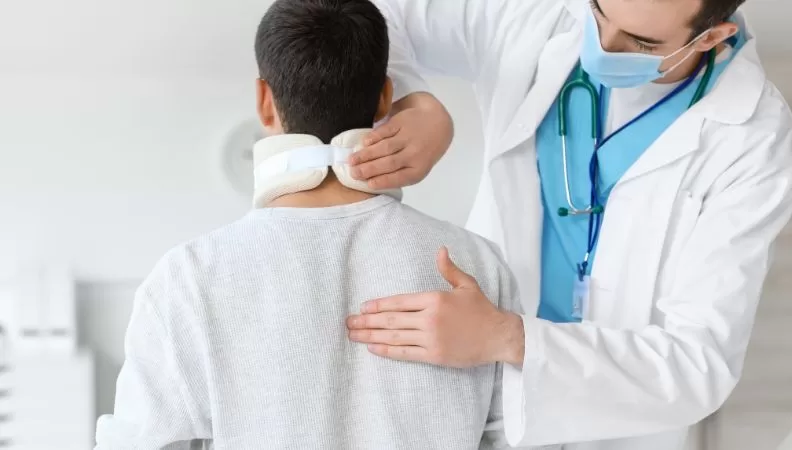Spinal Cord Stimulation Surgery
Spinal cord stimulation (SCS) is a therapeutic approach that utilizes electrical impulses to manage chronic pain, particularly in patients diagnosed with conditions such as failed back surgery syndrome. This innovative technique involves the implantation of a spinal cord stimulator, which emits mild electrical signals to the spinal cord, effectively interrupting pain signals before they reach the brain.
How Spinal Cord Stimulation Works
The spinal cord stimulator therapy is based on the modulation of pain perception by the process known as “gate control theory. In this theory, the electrical discharges produced by the stimulator are capable of interrupting the transmission of nociceptive signals, thus offering them to the patient important relief. Methods of this type are usually considered after conservative care, including physical therapy and drugs, do not work, and represent an important choice for patients with chronic pain.
Key Components of SCS
Electrodes: Thin wires that are strategically placed near the spinal cord to deliver electrical impulses.
Pulse Generator: A battery-operated device implanted under the skin that controls the intensity and frequency of the electrical impulses.
Remote Control: A portable device for patients to set stimulation parameters (with the capability to set the stimulation parameters according to the patient’s comfort and pain) as needed.
Indications for Spinal Cord Stimulation Surgery
SCS is being used for a range of chronic pain illnesses, particularly when conventional therapies have not been effective enough. Common indications include:
Failed Back Surgery Syndrome: This disorder comprises continuous postoperative pain after spinal operations, which is commonly attributed to nerve damage or scar formation.
Complex Regional Pain Syndrome (CRPS): A chronic pain condition that typically affects limbs and is characterized by severe pain, swelling, and changes in skin color.
Neuropathic Pain: Nerve pain resulting from injury or dysfunction to a nerve including the feeling of burning and a tingling sensation.
Additional Indications
Other conditions that may warrant consideration for SCS include:-
Diabetic Neuropathy: Nerve damage caused by diabetes leads to chronic pain.
Post-Surgical Pain Syndromes: Postoperative pain after several surgical procedures, including back surgery.
The Spinal Cord Stimulation Procedure
a trial and a permanent implantation.
Trial Spinal Cord Stimulation
Preparation: Before the trial, patients undergo comprehensive evaluations, including psychological assessments and imaging studies like MRI or CT scans to determine suitability.
Implantation: In this minimally invasive surgery, electrodes are introduced into the epidural space by a small incision in the back. Local anesthesia is typically used.
Evaluation Period: Patients test the trial system for about a week. During this time, they assess pain relief and functionality. If at least a 50% improvement in pain is reported, permanent implantation may be considered.
Permanent Spinal Cord Stimulator Implantation
If the trial is successful, a permanently implanted device is used. This involves:
Surgical Procedure: The patient is operated on on an outpatient basis, leads are trialed, and permanently implanted.
Device Connection: Leads are connected to a pulse generator implanted subcutaneously, typically at the waist or abdomen.
Benefits of Spinal Cord Stimulation
Spinal cord stimulation is a treatment of choice for chronic pain patients:-
Significant Pain Relief: Patients commonly report significant decreases in pain levels, with pain relief occurring within days of implanting.
Improved Quality of Life: Enhanced ability to perform daily activities and engage in social interactions leads to an overall better quality of life.
Reduced Medication Use: SCS has the potential to reduce opioid and other medication dependence and associated adverse effects by prolonging their use.
Real-Life Impact
An example is a study in Pain Medicine that indicates that spinal cord stimulators improved the pain of over 70% of patients after treatment compared to their pre-treatment pain.
Risks and Complications of SCS Surgery
Although SCS can be useful, one needs to think of possible risks:-
Surgical Risks: Like any surgical intervention, there are risk of infection, hemorrhage, and nerve injury during implantation.
Device Malfunction: Problems associated with the stimulator may necessitate additional surgery to replace or calibrate.
Post-operative Pain: Implantation site discomfort is frequent and treatable with medication.
Long-Term Considerations
Healthcare providers should also inform patients that some will show a decrease in device effectiveness with time or will require modification of settings based on the changes in pain intensity or lifestyle.
Post-operative care After Spinal Cord Stimulation
Post-operative care is critical for recovery and includes:-
Monitoring for Complications: Patients should be aware of signs of infection (redness, swelling) or complications (too much blood to lose).
Gradual Resumption of Activities: Patients should slowly reclaim normal daily life according to their physician’s advice.
Regular Follow-Ups: Periodic follow-ups are crucial to determine device functionality and implement the required adaptations.
Lifestyle Adjustments
Patients also have to undergo lifestyle modifications after surgery, e.g., undergoing physical therapy or learning an altered exercise regimen according to their ability.
Trial vs. Permanent Spinal Cord Stimulator
The distinction between trial and permanent spinal cord stimulators lies in their purpose:-
Trial Stimulator: A temporary system used primarily to evaluate effectiveness before committing to permanent implantation. It enables the possibility for both to factor in what is likely to work best for them on a long-term basis without having made any long-term commitment to SCS.
Permanent Stimulator: A long-term solution designed for ongoing pain management. After implantation, it, offers continuous management customized to each patient’s requirements.
Patient Selection for Spinal Cord Stimulation
Patient selection criteria are vital for successful outcomes. Ideal candidates typically:
Have chronic pain that has not responded adequately to other treatments.
Have comprehensive psychological assessments to make certain that they are appropriate for the implantation of a device.
Follow specific medical recommendations in relation to their general state and pain.
Importance of Comprehensive Evaluation
A multidisciplinary team approach involving neurologists, pain specialists, psychologists, and surgeons can help ensure that they appropriately select candidates based on comprehensive assessments.
SCS Device Technology and Innovations
Recent developments in spinal cord stimulator technology have made treatment significantly more effective:-
Rechargeable Batteries: Newer devices have rechargeable batteries which optimize device life span and decrease the frequency of replacement, compared to devices with non-rechargeable batteries.
Adaptive Stimulation Technology: A subset of more sophisticated devices are able to automatically change stimulation patterns according to the patient’s activity level or according to sensors placed inside the device system.
Future Trends
Current research is also investigating new technologies including closed-off systems that track nerve activity and dynamically adjust for activation in real-time in order to achieve optimal results.
Comparative Effectiveness of SCS vs. Other Treatments
Research indicates that SCS can be more effective than traditional pain management approaches, such as physical therapy or medication alone. Furthermore, studies support an increase in satisfaction rates among patients treated with spinal cord stimulation. Additionally, these patients often report better long-term outcomes. Moreover, spinal cord stimulation appears to address chronic pain more comprehensively. In contrast, patients treated exclusively with a pharmacological approach may experience limited relief. Therefore, combining SCS with other treatments could enhance results. Ultimately, the evidence suggests spinal cord stimulation offers a promising alternative for managing chronic pain.
Evidence from Clinical Studies
A systematic review that appeared in Anesthesiology demonstrated that not only is SCS superior in pain relief, but SCS also leads to superior functional outcomes compared to standard treatments with opioid medications or muscle physical treatment alone. Moreover, the study highlighted the long-term benefits of SCS in managing chronic pain effectively. Additionally, SCS offers a more sustainable option for patients seeking alternatives to opioids. Furthermore, it promotes improved mobility and functionality. A systematic review confirmed that SCS provides these benefits without the risks often associated with long-term opioid use. Therefore, SCS represents a promising treatment. Ultimately, this review underscores the potential of SCS to transform chronic pain management.
Conclusion
The spinal cord stimulation surgery is an important step for the management of chronic pain in patients. Moreover, it is especially beneficial for those who could not benefit from traditional therapies. Additionally, this procedure offers a promising alternative for long-term pain relief. Furthermore, it targets pain more effectively than many conventional methods. In contrast, traditional therapies often fail to address severe chronic pain comprehensively. Therefore, spinal cord stimulation is increasingly recommended for suitable patients. Ultimately, it provides hope for a better quality of life. Along with continuing technological advances and improvements in technique, SCS is a continuing mainstay in integrated pain management approaches.



